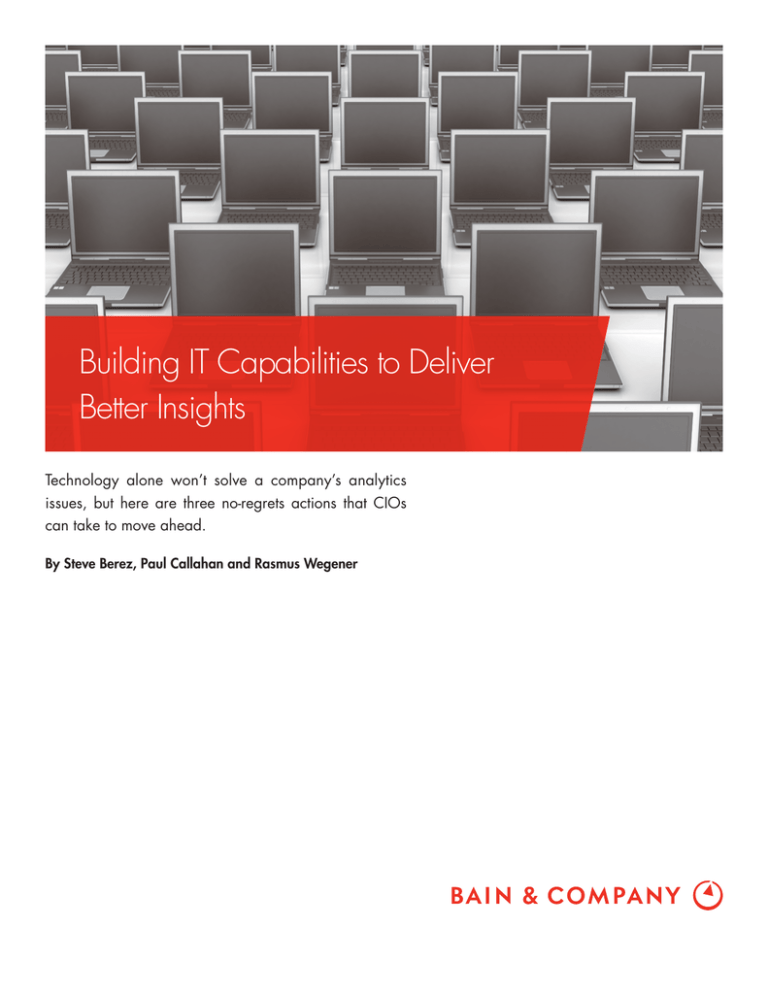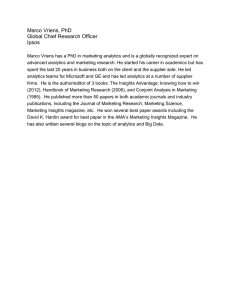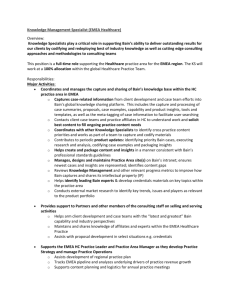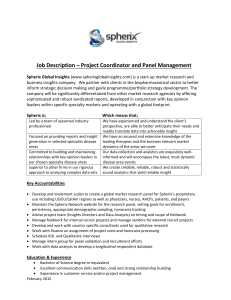
Building IT Capabilities to Deliver
Better Insights
Technology alone won’t solve a company’s analytics
issues, but here are three no-regrets actions that CIOs
can take to move ahead.
By Steve Berez, Paul Callahan and Rasmus Wegener
Building IT Capabilities to Deliver Better Insights
gaged a vendor to consolidate various pools of data to
provide essential insights. The IT team had wanted to
invest first in fixing the underlying problem, which
was a proliferation of different data systems resulting
from years of acquisitions. The vendor’s analytics solution delivered insights, but also raised the cost of
rationalizing the data later.
Any CIOs who have heard their business executives
boasting about “going around IT” should be concerned for their jobs.
We hear this sort of thing frequently, particularly
from executives who have been talking with technology vendors that promise to solve their analytics
problems with new technologies that glean business
insights from vast amounts of data.
•
And while it’s true that data and analytics will change
the way companies succeed in almost every industry,
no company can hope to fully benefit from analytic
insights unless they undertake the hard work of
building their internal capabilities for managing data
and integrating the insights into operations.
Most CIOs and other senior IT executives know their organizations are not prepared to make full use of the waves of
data coming into their organization. A Bain survey of 325
global companies found that 59% of those organizations
believe they lack the capabilities to generate meaningful
business insights from their data. In another Bain survey of
250 companies, 85% said they will require substantial investments to update their existing data platform, which includes consolidating and cleaning data, simplifying access
and rights management, and improving access to external
data sources.
Given that they understand how far they have to go, what
keeps them from getting started? In our experience working with hundreds of companies around the world, we
find that three major obstacles get in the way.
•
The divide between ownership and stewardship of
data. IT may not always know where the value resides
in data, while executives on the business side may not
understand the intricacies of data storage and management. This disconnect can have expensive consequences if the business (which owns the data) and IT
(the data stewards) make decisions without a solid understanding of each other’s perspective.
Sometimes, point solutions from vendors can make
the problem worse. In one case, business executives
at a North American manufacturing company en-
Overreliance on technology. IT departments budget
and plan in terms of applications and infrastructure,
but data has always been at the center of the effort.
Historically, IT departments focused on how and
where to store data and how to keep it secure. But
companies don’t create value by storing data or managing rights. Increasingly, value will come from making data available to the right people who can use it to
derive insights and create business value.
It’s this last part of the equation—putting data in the
hands of business people—where a lot of companies
stumble. In many cases, they leave it up to IT to figure out how to create new value from data. Most IT
organizations, though, were built with a focus on the
T, technology, rather than the I. Previously it was
enough to deliver comprehensive reports on current
data sets, but today IT must work closely with the
business to understand what’s possible and how the
business can make the best use of data.
•
Old processes that no longer fit business needs.
Old architectures and processes may be out of
date in the current business environment, where
no one can predict who will want what data and
for what purpose. Data platforms will need to
evolve to support a wider range of use cases. For
example, enterprise data warehouses used to be
the centerpiece of data landscapes. These were
treated as walled gardens, protecting a company’s
most valuable data and restricting access to only a
few—which is increasingly unworkable in organizations where many need to access the data,
including those who may want to “play” with the
data to make discoveries.
More sophisticated cases beg the need for more
advanced architectures to access, integrate and vir-
Building IT Capabilities to Deliver Better Insights
tualize data sets for consumption and analysis. For
these uses, cloud-based infrastructure can work
better than on-premise systems because they can
be scaled up, provisioned on-demand and paid for
on a consumption basis.
Unfortunately, few organizations have a clear
point of arrival and roadmap for their data platforms to support the massive growth of data along
with the challenge of managing legacy systems;
fewer have a well-defined, systematic approach to
execute. And only the very best performers have
established relationships between IT and the business that focus on generating valuable insights as
the primary goal of technology. Most well-established companies need to critically review and revamp their plans and approaches to data management in order to optimize technology investments
and reduce the likelihood of costly lock-in and inflexible proprietary point solutions.
No-regrets moves to support analytics
These barriers are common, but not insurmountable.
Our work with organizations around the world shows
that organizations can develop the capabilities to deliver effective data management in the age of advanced analytics. Sometimes, but not always, a
change in technology management prompts the revitalization. But whether or not technology leadership
has changed, there are several things any organization can do to begin to close the gap between their
data capabilities and those of analytics leaders.
•
Continue to prioritize where technology will deliver
the most value. As IT executives begin to build up
analytics capabilities, they need to continue to let
business decisions determine investments. A process to explore the business opportunities can help
discover where there’s value and then use those insights to prioritize the investment in IT. A solid focus
on long-term business priorities will help companies
look beyond current fads and buzzwords and toward
building sustainable analytics capabilities.
•
Upgrade while keeping a legacy system running.
The risk in prioritization based on business value
is that it can make it difficult to address underlying
issues that can affect productivity in the long
term—such as different versions of customer data
spread across multiple systems. Some of these are
no-regrets actions that IT can act on immediately.
Others may be further out of view, things that IT
must do to unlock access to data—and which may
not be tied to an urgent business need. Since in
most companies the capital budget is tied up in
“keeping the lights on” and responding to business demands, it can be difficult to place these in
the work schedule, but finding ways to do so will
return benefits down the road.
•
Change the ways of working. Traditional data
management processes—for example, extracttransform-load (ETL)—have served companies
well in the past. But they break down when analytics and applications have real-time requirements. One way to keep up is to bring the business closer to the development process. Agile
development methods, which build applications
more incrementally with frequent input and review from the business, are an essential step in
that direction. So too is the concept of DataOps:
Just as DevOps improves efficiency by increasing collaboration between application development and operations, a DataOps mentality focuses the organization on improving the way
that business leaders, data scientists and IT
managers work together to discover insights.
Plenty of CIOs will fail to push their IT departments
beyond traditional data management into a realm
where their technology makes it easy for executives
to access data and derive valuable business insights.
Successful CIOs, however, will be those who move
from a technologist’s view to one that allows a
broader swath of business users to access data, experiment with analytics and derive new insights that
deliver meaningful value to the organization.
Key contacts in Bain’s Global Information Technology practice
Americas
Franz Bedacht in São Paulo (franz.bedacht@bain.com)
Steve Berez in Boston (steve.berez@bain.com)
Paul Callahan in Atlanta (paul.callahan@bain.com)
Rudy Puryear in Chicago (rudy.puryearha@bain.com)
Rasmus Wegener in Atlanta (rasmus.wegener@bain.com)
Asia-Pacific
Arpan Sheth in Bangalore (arpan.sheth@bain.com)
Europe,
Middle East
and Africa
Stephen Phillips in London (stephen.phillips@bain.com)
Steve Berez is a partner with Bain & Company in Boston, where he leads the IT practice in the Americas. Rasmus Wegener
is a Bain partner in Atlanta and the founder of Bain’s Advanced Analytics practice. Paul Callahan is a principal in Atlanta,
where he works with Bain’s Global IT practice.
The authors would like to acknowledge the contributions of Sukumar Kalmanje, a senior data scientist with Bain & Company’s
Advanced Analytics Group in Silicon Valley.
For more information, visit www.bain.com
Copyright © 2016 Bain & Company, Inc. All rights reserved.







